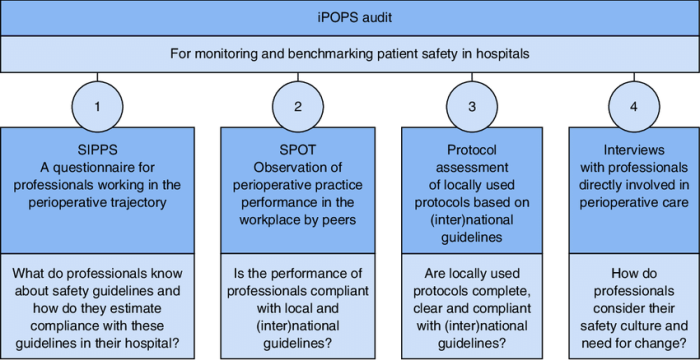
Embark on a journey through the realm of Patient Safety Audits, where meticulous scrutiny leads to enhanced healthcare quality and patient well-being.
Explore the pivotal role of audits in identifying risks, improving care, and fostering a culture of safety in healthcare settings.
Patient Safety Audits
Patient safety audits in healthcare settings involve systematic evaluations to assess the safety practices, protocols, and procedures in place to protect patients from harm or errors during their medical care.Regular patient safety audits are crucial for identifying potential risks, improving processes, and ultimately enhancing the overall quality of patient care. By conducting these audits, healthcare facilities can proactively address any safety concerns and prevent adverse events from occurring.
Key Areas Covered in Patient Safety Audits
- Medication Management: Ensuring proper administration, storage, and monitoring of medications to prevent errors.
- Infection Control: Implementing protocols to reduce the risk of healthcare-associated infections.
- Staff Training: Providing ongoing education and training to healthcare staff to maintain high standards of patient safety.
- Fall Prevention: Implementing strategies to prevent patient falls and related injuries.
- Emergency Preparedness: Ensuring facilities are equipped to handle emergencies and disasters effectively.
Benefits of Patient Safety Audits
Patient safety audits play a crucial role in healthcare systems by identifying potential risks to patients and improving overall healthcare quality. These audits are essential in ensuring that patients receive safe and high-quality care during their medical treatment.
Identifying Potential Risks to Patients
Patient safety audits help healthcare facilities identify potential risks that could harm patients during their care. By conducting regular audits, healthcare providers can assess their processes, systems, and practices to identify areas where patient safety may be compromised. For example, audits may reveal issues such as medication errors, surgical complications, or inadequate infection control measures. By addressing these risks proactively, healthcare facilities can prevent adverse events and ensure patient safety.
Improving Overall Healthcare Quality
Patient safety audits contribute to improving overall healthcare quality by promoting a culture of safety and continuous improvement. Through audits, healthcare providers can evaluate the effectiveness of their safety protocols, communication strategies, and quality assurance processes. By identifying areas for improvement, healthcare facilities can implement changes to enhance the quality of care delivered to patients. This ultimately leads to better health outcomes and increased patient satisfaction.
Positive Outcomes in Patient Care
Patient safety audits have led to numerous positive outcomes in patient care. For example, audits have helped reduce the rate of healthcare-associated infections, prevent medication errors, and improve patient outcomes following surgical procedures. By implementing recommendations from audits, healthcare facilities have been able to enhance patient safety, reduce medical errors, and provide more effective and efficient care to patients.
Conducting Patient Safety Audits

To ensure the highest level of patient safety, healthcare facilities conduct regular patient safety audits. These audits involve a systematic review of processes, procedures, and practices to identify areas for improvement and ensure compliance with safety standards.
Process Involved in Conducting Patient Safety Audits
- Establish audit objectives and scope: Define the goals and boundaries of the audit to focus on specific areas of patient safety.
- Collect data: Gather relevant information such as incident reports, patient records, and feedback from staff and patients.
- Conduct on-site visits: Observe workflows, interactions, and protocols firsthand to assess compliance with safety measures.
- Analyze findings: Review data collected to identify trends, root causes of errors, and areas of non-compliance.
- Develop recommendations: Based on the analysis, propose actionable steps to address identified issues and improve patient safety.
- Implement changes: Work with healthcare professionals to implement recommended changes and monitor their effectiveness.
Role of Healthcare Professionals in Carrying Out Patient Safety Audits
- Healthcare professionals play a crucial role in conducting patient safety audits as they have firsthand knowledge of clinical practices and patient care.
- They are responsible for providing accurate data, participating in on-site visits, and collaborating with auditors to identify areas for improvement.
- Healthcare professionals also contribute to the development and implementation of recommendations to enhance patient safety standards.
Tips on Effectively Implementing Recommendations Following a Patient Safety Audit
- Communicate findings: Ensure clear and transparent communication of audit results and recommendations to all staff members involved in patient care.
- Provide training: Offer training sessions to educate healthcare professionals on new protocols, procedures, and best practices following the audit.
- Monitor progress: Establish mechanisms to monitor the implementation of recommendations and track the progress of changes over time.
- Solicit feedback: Encourage feedback from staff and patients to continuously improve patient safety practices based on real-time experiences and observations.
- Celebrate successes: Acknowledge and celebrate milestones achieved in enhancing patient safety to motivate staff and sustain a culture of safety.
Patient Safety

Patient safety in healthcare refers to the measures and protocols put in place to prevent harm or risks to patients during their medical care. It encompasses ensuring that patients are protected from errors, infections, accidents, and any other potential hazards that may arise during their treatment.Ensuring patient safety in healthcare organizations is of utmost importance as it not only impacts the well-being and recovery of patients but also plays a crucial role in maintaining trust and credibility with patients and their families.
By prioritizing patient safety, healthcare organizations can reduce medical errors, improve patient outcomes, and enhance overall quality of care.
Initiatives to Enhance Patient Safety
- Implementation of electronic health records (EHRs) to improve accuracy and accessibility of patient information.
- Standardizing protocols and procedures to reduce variability in care delivery and minimize errors.
- Regular training and education for healthcare staff on best practices in patient safety.
- Encouraging open communication and transparency between healthcare providers, patients, and families.
- Utilizing technology such as barcode medication administration to prevent medication errors.
As we conclude our exploration of Patient Safety Audits, it becomes evident that these audits are not just a routine check but a powerful tool for elevating patient care standards and safeguarding lives.
Answers to Common Questions
How often should patient safety audits be conducted?
Patient safety audits should ideally be conducted regularly, depending on the healthcare facility’s policies and procedures.
Who typically conducts patient safety audits?
Healthcare professionals with expertise in quality assurance and patient safety are usually responsible for conducting these audits.
What happens after a patient safety audit uncovers areas of improvement?
After identifying areas for improvement, it is crucial to implement the recommended changes promptly to enhance patient safety.





